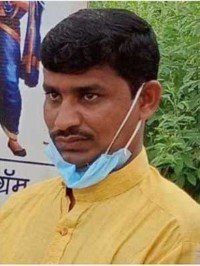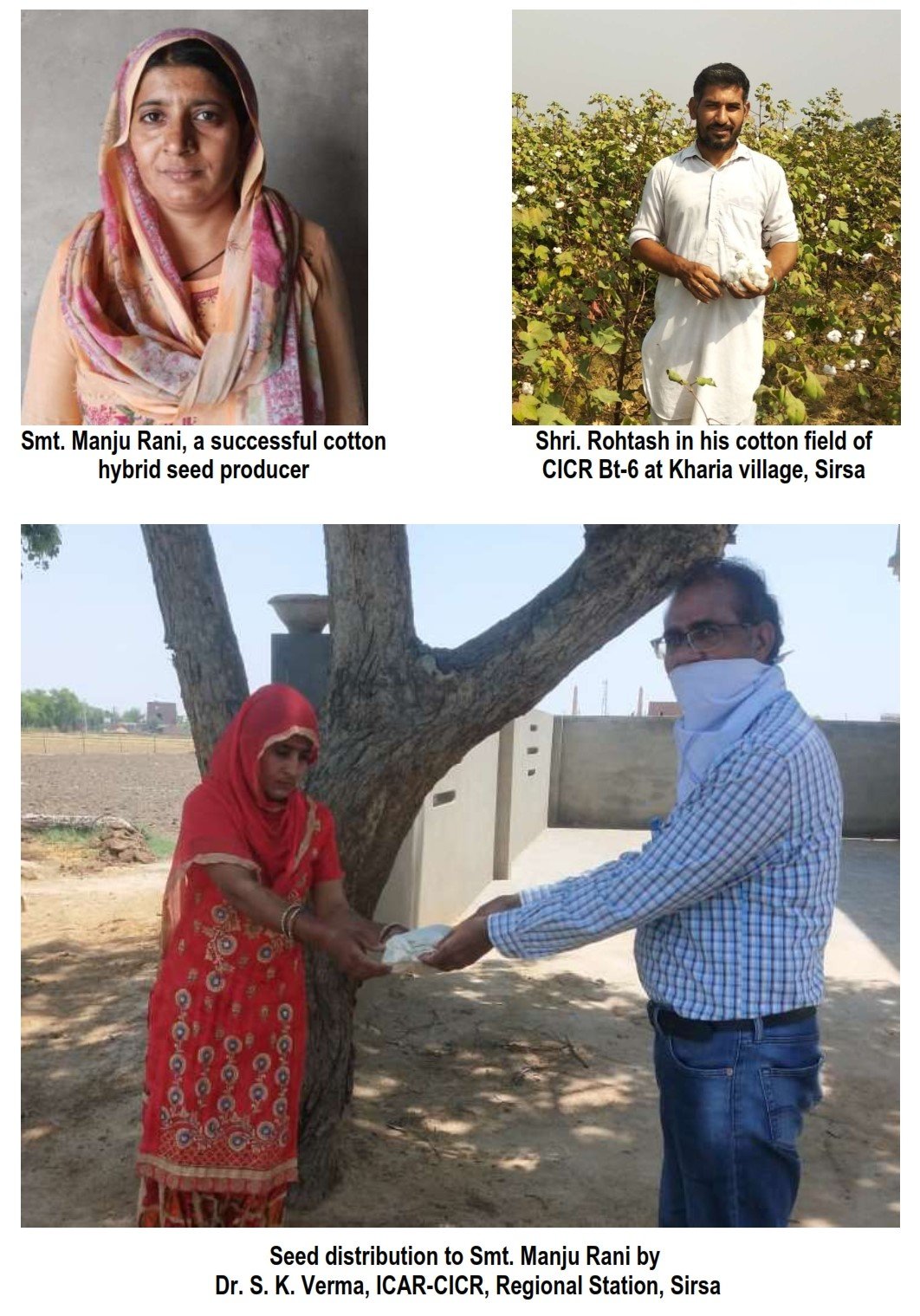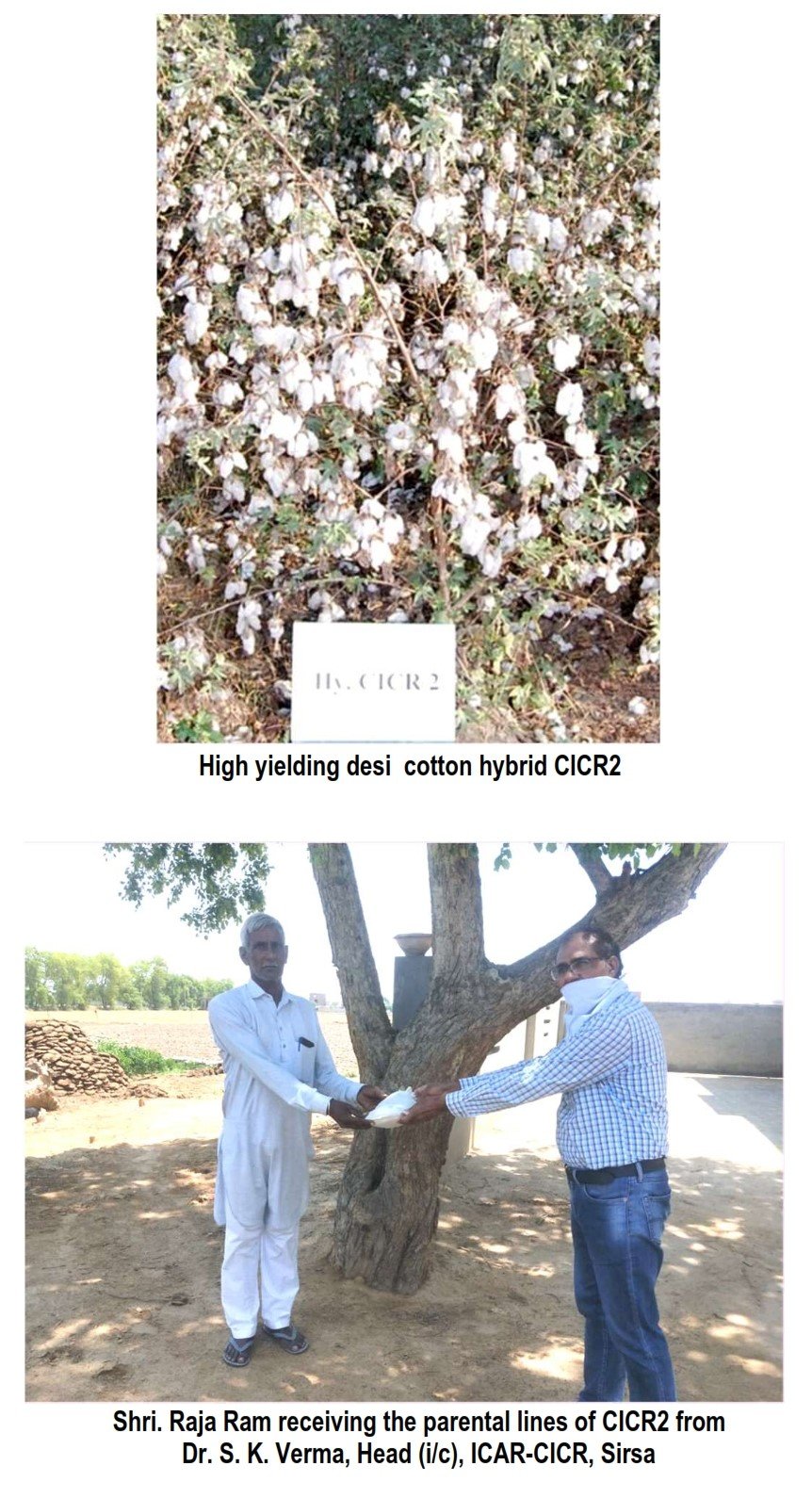In cotton, there are two types of branches viz., monopodia (vegetative) and sympodia (reproductive). The monopodia are considered less productive than the sympodia. An innovative idea proposed by a progressive farmer Shri. Dadasaheb Lad was executed by Shri. Rameshwar Ambore at his farm in Sipora Ambora village, Jafrabad taluk, Jalna district of Maharashtra. The crop was sown at 90 x 30 cm spacing on 30th May, 2020. Mr. Ambore started cutting the monopodia of the cotton plants at 30-35 days after sowing which allowed the sympodia to grow longer. Once the cotton crop attained one meter height, it was de-topped. These processes enabled the cotton plants to utilize the sunlight and nutrients more efficiently and this increased the fruiting efficiency. He adopted recommended the package of practices for nutrient and water management and undertook need based plant protection measures.
Mr. Ambore s estimate about the yield was that each plant would bear 50 bolls with average boll weight of 5.0 g thus providing 250 g/plant. At a spacing of 90 x 30 cm there would be of 14,000 per acre. This translates to 35 quintals seed cotton per acre. Shri. Ambore informed that he harvested 33 quintals of seed cotton per acre when this technique was combined with drip irrigation with poly¬mulch. After harvesting cotton, the farmer took up sowing of wheat crop on 15th November, 2020 in rabi season. It is pertinent to note that stand alone agro-techniques viz., removal of monopodia, detopping after 100 days and poly-mulch with drip irrigation developed at ICAR-CICR, and evaluated and approved by ICAR-AICRP (2014) on Cotton. The effort of the farmer to effectively integrate them into a package is indeed commendable. Shri. Rameshwar Ambore can be contacted over phone at 9860679343 | ||
 |  |  |
| Cotton plant with profuse bearing | Shri. Rameshwar Ambore | Shri. Dadasaheb Lad interacting with Dr. S. K. Chaudhari, DDG (NRM), ICAR |
| As a part of outreach activities, the ICAR-CICR, Regional Station, Coimbatore had initiated National Food Security Mission (NFSM) funded project on “Insecticide Resistance Management (IRM): Dissemination of pink bollworm strategies” in Kinathukadavu block of Coimbatore District, Tamil Nadu from 2018. During the current season, 50 farmers from Palanigoundanur, Muthugoundanur, Sokkanur, Veerappagoundanur, Sattakkalpudur villages were adopted for the implementation of project activities. The farmers were trained on plant protection technologies through lectures, field demonstrations, group meetings and exhibitions. Farmers were imparted training on pest monitoring with pheromone traps, use of bio-control agents and safe handling of insecticides. The fields were monitored for sucking pests, natural enemies and boll damage at weekly intervals. The farmers were given critical inputs and advised to follow the plant protection measures. Shri. M. Rajannan (Mobile No:9600372527), an adopted farmer from the Sokkanur village with a land holding of 6.5 acres, cultivating cotton, tomato and bhendi, actively participated in the training programmes organized under IRM project. The farmer started using pheromone traps for pest monitoring; could identify various life stages of insect pests and their damage symptoms and learned the concept of economic threshold level (ETL) in deciding the timing of insecticide spray. He got trained on the use of biocontrol agents and release of egg parasitoid in cotton, safe handling of pesticides and timely crop termination to prevent pest carryover of pink bollworm in cotton. He used to get annual income of Rs. 3, 91, 226 from the crops and faced problems like pest and diseases, non availability of labour and increased input cost etc. With DFI interventions like better yielding and pest tolerant genotypes, supply of critical inputs like pheromone traps, biocontrol agents, insecticides, growth regulators etc., he is getting an annual income of Rs. 5, 97,825. By following the IRM strategies, he could reduce the number of insecticides his cotton crop as against 7-8 sprays by the neighboring farmers. He spent Rs. 9,240/ha for the pesticide sprays as against Rs.16, 850/ha by the non-IRM farmer which resulted in the reduction of cost of cultivation and increased net profit with a benefit cost ratio of 1.83 in cotton. |
 Shri. Rajannan Information provided by, Dr. K. Rameash, Principal Scientist (Agrl. Entomology), ICAR-CICR, Regional Station, Coimbatore Shri. Rajannan Information provided by, Dr. K. Rameash, Principal Scientist (Agrl. Entomology), ICAR-CICR, Regional Station, Coimbatore |
| I Success story of cotton hybrid seed producer: Smt. Manju Rani, W/o Sh. Vikram, Begu village, Sirsa, Haryana is a successful seed producer of CICR-2 (Desi cotton hybrid) developed by ICAR-CICR Regional Station, Sirsa, Haryana. She was imparted training on hybrid seed production of cotton by the station. She emerged as a role model and successful entrepreneur amongst the women of her village in hybrid seed production of cotton. Mrs. Manju Rani studied up to middle school level (i.e. 8th standard) and is practicing agriculture on 5.5 acres land along with her family. During the 2020-21 cropping year, she successfully produced 275 kg seed of CICR-2 and earned a gross income of Rs. 2,67,100/- from an acre of land under the FLD program on hybrid seed production of ICAR-AICRP on Cotton (NFSM-CC). The seeds of both male and female parents of CICR-2 were provided for crossing of flowers, tagging and picking of crossed bolls, ginning and other activities related to seed production. Success story of CICR Bt-6 variety: Shri Rohtash is a cotton farmer from Khariya village, Sirsa, Haryana and cultivator of CICR Bt-6 (a Bt cotton variety) developed by ICAR-CICR Regional Station, Sirsa, Haryana. He regularly participated in the training programs on cotton cultivation conducted by ICAR-CICR Regional Station, Sirsa. Shri. Rohtash studied up to the senior secondary level (i.e. 12th standard) and is practicing agriculture on 3.0 acre land along with his family. During the 2020-21 cropping year, he successfully produced 2275 kg seed cotton yield per hectare under the FLD program on Integrated Crop Management (ICM) as part of ICAR-AICRP on Cotton (NFSM-CC). CICR Bt-6 variety came up well on his marginal land with low soil fertility and poor irrigation facilities, where Hybrid Bt cotton could not be successfully cultivated during the previous years. Shri. Rohtash sussessfully targeted suitable variety ie CICR Bt-6 that performed well in shallow soils in comparison to commercial hybrids. | ||
 | ||
| Of the four cultivated species of cotton. Asiatic cotton (Gossypium arboreum) popularly referred as desi cotton’ is indigenous in origin and possesses inherent ability to adapt to adverse climatic conditions. Desi cotton ruled the cotton area and production in India prior to independence. The American and Egyptian cottons were introduced to India in 1790 and 1831. respectively. The development of hybrid cotton since 1970 s and commercial approval of Bt cotton since 2002 have provided major boost to upland cotton in India and adversely impacted desi cotton cultivation in India. But Desi cotton is still under cultivation in some part of India as farmers believe in the yield sustainability of desi cotton especially in marginal soils and under low management practices. There is a big demand for short staple and coarse desi cotton which is mostly used as surgical cotton due to its better absorption capacity and also in making denim. In cotton growing tracts of North India in Punjab. Haryana and Rajasthan, the desi cotton is planted during the month of April to early May after harvest of Wheat. Barley. Mustard and Gram. To cater to the need of these desi cotton farmers. ICAR- Central Institute for Cotton Research (CICR), Regional Station. Sirsa had developed and released a GMS based hybrid CICR 2 in 2005 for commercial cultivation in north zone comprising the states of Haryana. Punjab and Rajasthan. This hybrid was developed by crossing DS-5 (GMS) as female parent and LD 327 (Sei.) as mal parent. It has erect plant type and grows up to 150 cm in fertile soils and gives better response to good crop management practices. With duration of 160 -170 days, the average yield potential of this hybrid can be up to 32.13 quintals/ha. This hybrid has fluffy boll opening and better locule retention. It possesses 2.5% span tensm of 20.5mm. micronaire value of 7.06. fibre strength of 16.3 and ginning outturn of 38.4%. |
 |
| The development of desi cotton hybrids using male sterile system eliminates the process of emasculation as the anthers born on the female parent are sterile thus leading to reduction in cost of hybrid seed production. However, pollination needs to be done manually. CICR has taken up 21 training programs from 2007 to 2018 to impart the skills required for hybrid seed production to more than 450 farmers. Shri. Raja Ram and Smt. Manju Rani from Begu. Sirsa. Haryana were one of the best beneficiaries the trainings imparted by ICAR-CICR and now they are prosperous seed producers of CICR 2. They have been producing hybrid seeds of CICR 2 since 2006. Initially they started producing seeds in 2 kanals (1000m2 i.e., 1/8th of an acre) and produced 90 kg seeds which was sold for Rs.300/kg. With the ceaseless motivation and support of Scientists from ICAR-CICR. Sirsa they continued producing the hybrid seeds for last 16 years. They produced a total of 195 kg seed of this hybrid from an area of 1.25 acres in 2017 and sold to farmers of Fatehabad. Faridkot & Hanumangarh districts for Rs.1000/kg. During 2020, the produced 236 kg of CICR 2 from 1 acre area and sold them at Rs. 1000/kg to the farmers of Bathinda. Ferozepur, Sirsa. Hissar. Fatehabad. Bhiwani. Mahendergarh, Rewari. Charkhi Dadri & Hanumangarh. Over the years, they have produced over 30 quintals of CICR 2 and have distributed to the cotton farmers in districts of Sirsa. Hissar. Faridkot. Fatehabad. Hansi, Ludhiana. Rewari. Charkhi Dadri. Hanumangarh. Bhiwani and Sriganganagar in three states Punjab. Haryana and Rajasthan. Their testimony on hybrid seed production of CICR 2 is acting as one of the key motivating factors for other cotton growers in the region to take up hybrid seed production and continue to cultivate desi cotton. |
| Extra-long staple (ELS) Bt Cotton Hybrid DCH 32 benefits farmers in southern dry zone of Karnataka Cotton is one of the most important commercial crops, which plays a vital role in livelihood security of the farmers in southern dry zone of Karnataka. Mysore and Chamarajnagar are the leading cotton growing districts of the zone. Traditionally this zone is known for cultivation of Extra Long Staple (ELS) cotton, due to its favourable climatic conditions. Prior to the introduction of Bt cotton hybrids, the predominant cultivar cultivated in the zone was DCH- 32. But. in the current era of Bt cotton, the area under non-Bt version of DCH 32 declined. During the year 2019- 20. with the introduction of DCH-32 Bt cotton (BGII) by Karnataka State Seed Corporation (KSSC). the ICAR-AICRP on Cotton. Chamarajanagar centre attempted to introduce DCH-32 Bt cotton in farmers’ field through Front Line Demonstrations (FLDs) under the National Food Security Mission on Cotton – Commercial Crops. Sri Siddappa S/o Basappa. is a young progressive farmer from Taglur village, in Begur Hobli of Gundlupet taluk. Chamarajanagar District. He owns six acres of land and adopts Integrated Farming System (IFS) concept for sustainable agriculture. He opted for demonstration of new DCH-32 Bt cotton in his field under the supervision of ICAR-AICRP scientists. He took up the sowing in the month of April 2020 at a spacing of 90 x 90 cm following recommended package of practices. Gap filling was taken with seedlings that were raised in polythene bags after the occurrence of rains. Seeing the good establishment of crop, higher number of bolls per plant and good boll size achieved attracted the neighbouring farmers to visit his field regularly and they started showing interest in DCH 32 Bt cotton. Consequently, the officials from the Karnataka State Department of Agriculture and Karnataka State Seed Corporation also visited the demo field. A field day was organized for farmers in the presence of Dr. A H. Prakash. Project Coordinator (Cotton Improvement), Dr. Y.G. Sadakshari. Director of Research. UAS. Bangalore. Dr. S.N. Vasudevan. ADR. ZARS, VC Farm. Mandya. JDA of KSDA. Director of KSSC. Scientists of ICAR-AICRP on Cotton and KVK. Under rainfed conditions, a good yield of 2000 kg/ha was harvested eliciting interest of other farmers in the adoption of the ELS hybrid. As a result, during the year 2020-21, ICAR-AICRP on Cotton. Chamarajanagar implemented 50 acres of frontline demonstration in farmers’ fielda on ELS cotton realizing an average seed cotton yield of 1481 kg/ha (11.9% higher yield) as against farmers’ practice of 1324 kg/ha. Cost of cultivation, gross return, net return and B:C ratio per hectare were Rs. 42184. Rs.81455. Rs.39271 and 1.93. respectively in FLD fields and Rs.39930. Rs.72820. Rs.32890 and 1.82 respectively under farmers’ practices. The efforts of the farmer and the centre paved way for re-entry of DCH 32 Bt cotton in the southern dry zone of Karnataka which will benefit many rainfed ELS cotton growers. Information provided by. |
 |
| Information provided by. Dr. C. SHASHI KUMAR. Assistant Agronomist & Scheme Head. ICAR-AICRP on Cotton. KVK Campus. Haradanahalli farm. Chamarajanagar-571127 email: shashiagron76@gmai.com |
| Increase in net profit by adopting IRM strategies in cotton: Shri. Ramaraj from Kinathukadavu shares his success story The ICAR-CICR. Regional Station. Coimbatore has been implementing National Food Security Mission (NFSM) funded project on ‘Insect Resistance Management (IRM): Dissemination of Pink bollworm management strategies” at Kinathukadavu Block of Coimbatore District. Tamil Nadu since 2018. During 2018-2020, a total of 50 farmers from five villages viz.. Kallapuram. Sikkalampalayam, Vadaputhur. Singaiyanputhurand Sola van palayamand during the current season, 50 farmers from Palanigoundanur. Muthugoundanur, Sokkanur. Veerappagoundanur. Sattakkalpudur villages were adopted for the implementation of project activities. The adopted farmers were sensitised on plant protection technologies through lectures, training programmes, field demonstrations, group meetings and exhibitions. Awareness on pest monitoring with pheromone traps, use of bio¬control agents and release of egg parasitiod in cotton, safe handling of pesticides and timely crop termination to prevent of pest carryover of pink bollworm in cotton were imparted to the cotton growers. Live specimens of pests with their photographs and natural enemies were displayed to enhance the farmers knowledge by better understanding about the pest and nature of damage. The population of sucking pests, natural enemies, bollworms and fruiting body damage like green boll damage, open boll damage and locule damage were monitored at weekly intervals and accordingly the farmers were advised to follow the plant protection measures. Adopted farmers were also supplied with critical inputs like pheromone traps, pesticides and biocontrol agents for the timely management of pink bollworm and sucking pests. Shri N. Ramaraj (Mobile number 9787588571), a progressive farmer cultivating cotton, tomato, cowpea and brinjal at his farm at Singaiyanpudur actively participated in the events organised under the project. He volunteered for learning the pest monitoring using pheromone traps, identification of pests and damage symptoms and the concept of economic threshold level (ETL) in deciding the timing of insecticide spray. By following the IRM strategies, he could reduce the number of insecticides spray by 4 in his cotton crop as against 8-9 sprays by the neighbouring farmers. He spent Rs. 8.130/ha for the pesticide sprays as against Rs.15.500/ha by the non-IRM farmer which resulted in the reduction of cost of cultivation and increased net profit with a benefit cost ratio of 1.62. He shared his experience of adopting better pest management strategy and obtaining increased net profit in cotton at the CICR- Farmers interaction programme broadcast by the All India Radio. Coimbatore on 16 March 2021 in the ‘Erum Oorum” (Tamil) (“The Plough and The Village”) programme. The knowledge gained in the IRM project is helping the farmers in the monitoring and management of insect pests in other crops also. In addition to cotton. Mr. Ramaraj installed pheromone traps in his brinjal and tomato crops as well for the pest monitoring and undertakes timely management of insect pests in other crops as well. |
 |
 |
| Information provided by. Dr. K. Rameash Principal Scientist (Agri. Entomology). ICAR-CICR Regional Station. Coimbatore |



